HI All,
Seeking some help with my build... I am in the process of building my first full range speakers with some Alpair 10P's. This is also my first attempt at a ported box and I thought I would go for a SBB4 alignment.
Using a simple app and the datasheet specs, I came up with the box design in the first image below. This is in approx. agreement to what I got doing the same design with WinISD.
The datasheet specifies the Fs of the 10P as 42Hz. However, today I tested the drivers with a DATS V3 and the resonant frequency seems to differ markedly from the spec sheet - see the impedance plots below. One is 55Hz and one is 47Hz. While I know specs often deviate from the spec sheet, this difference is more than I was expecting and if correct would mean my design may not work very well. 47Hz is almost tolerable but 55 seems pretty off.
I am seeking advice on where to go from here. Do I alter the box design to suit the measured Fs or stick to the original plan? I have already cut the panels but still have the opportunity to alter the port length or make the box smaller by using some kind of internal space filler. Could the DATS results be off or unreliable somehow? I tested some 6" sbacoustics drivers as well and they were nearly spot on.
Appreciate any advice anyone might have!



Seeking some help with my build... I am in the process of building my first full range speakers with some Alpair 10P's. This is also my first attempt at a ported box and I thought I would go for a SBB4 alignment.
Using a simple app and the datasheet specs, I came up with the box design in the first image below. This is in approx. agreement to what I got doing the same design with WinISD.
The datasheet specifies the Fs of the 10P as 42Hz. However, today I tested the drivers with a DATS V3 and the resonant frequency seems to differ markedly from the spec sheet - see the impedance plots below. One is 55Hz and one is 47Hz. While I know specs often deviate from the spec sheet, this difference is more than I was expecting and if correct would mean my design may not work very well. 47Hz is almost tolerable but 55 seems pretty off.
I am seeking advice on where to go from here. Do I alter the box design to suit the measured Fs or stick to the original plan? I have already cut the panels but still have the opportunity to alter the port length or make the box smaller by using some kind of internal space filler. Could the DATS results be off or unreliable somehow? I tested some 6" sbacoustics drivers as well and they were nearly spot on.
Appreciate any advice anyone might have!
Last edited:
Oh crap, I see my mistake. The F0 on the datasheet is the infinite baffle resonant frequency not free air...
Ok I am going to have to redesign this thing... and it looks like the box design will have to be slightly different for each driver - one at 55hz and one at 47hz.
Ok I am going to have to redesign this thing... and it looks like the box design will have to be slightly different for each driver - one at 55hz and one at 47hz.
OK...so I have been thinking. My box is made from 18mm ply. Its empty volume is about 17.2L. With all the bracing I was planning it was going to come down to about 15L, which together with the port and speaker volume would bring it down to 14.3L as per my above design. The port ID is 4.28cm.
Now, if I only use one of my braces the box volume will be about 17.1L, which is mighty close to the design shown on the markaudio website here:
http://wodendesign.com/downloads/simpleReflex-103-10p-plan-100214.pdf
If I then increase the port length to 169mm to account for the smaller diameter I am using, my volumes will match the plans to within 0.1L. Maybe this is the way to go?
It would be a shame to remove nearly all the bracing from the design but perhaps it will be ok given the heavy construction? One brace consisting of a 1" dowel from the left to right side would remain.
Could this work and is anyone familiar with this design?
Now, if I only use one of my braces the box volume will be about 17.1L, which is mighty close to the design shown on the markaudio website here:
http://wodendesign.com/downloads/simpleReflex-103-10p-plan-100214.pdf
If I then increase the port length to 169mm to account for the smaller diameter I am using, my volumes will match the plans to within 0.1L. Maybe this is the way to go?
It would be a shame to remove nearly all the bracing from the design but perhaps it will be ok given the heavy construction? One brace consisting of a 1" dowel from the left to right side would remain.
Could this work and is anyone familiar with this design?
Did you run in the speakers like asked by the company? The FS goes down after a right run in of about 100h, this long runin is needed because of the spider mainly. T/S parameters do change after the run in.
I did design boxes for the Alpair 10, that should also fit the Alpair 10P (more or less the same t/s specs) and came to 17.9L for a tuning to 45Hz. You can find the plans here attached. I use these speakers daily in my office now.
Woden Design is the company of Scott Lindgren, known as Scottmoose here, and a specialist in Mark Audio drivers and consultant for the Mark Audio brand since longtime (He makes most of the Mark Audio plans advertised on their site and more). Other well proved design are those on the site of Planet10 (also often done by Scott): http://frugal-phile.com/boxes-markaudio.html
I did design boxes for the Alpair 10, that should also fit the Alpair 10P (more or less the same t/s specs) and came to 17.9L for a tuning to 45Hz. You can find the plans here attached. I use these speakers daily in my office now.
Woden Design is the company of Scott Lindgren, known as Scottmoose here, and a specialist in Mark Audio drivers and consultant for the Mark Audio brand since longtime (He makes most of the Mark Audio plans advertised on their site and more). Other well proved design are those on the site of Planet10 (also often done by Scott): http://frugal-phile.com/boxes-markaudio.html
Attachments
And that calculator is worthless btw, use winISD or VirtuixCad (both freeware) if you want to design serious boxes. Other good software also exist, but has a steeper learning curve, with as ultimate (in possibilities and learning curve) HornRSP (also freeware). Those webcalculators don't do it right, especially if they don't take a lot of T/S parameters in account that matter, like LE and BL.
Thanks for that Waxx.
Thanks for sharing the plans! They look great except I am hoping to get out of this pickle using the panels I have already cut, given the significant sum spent already. I might try them next time.
Very interesting on the T/S params changing so much with run in! My drivers are brand new. Do you know if I am right about the f0 thing? A quick google says it is the same as Fs, but digging deeper suggests it is actually the infinite baffle resonant frequency not free air.
Actually, thinking about it, a driver in an infinite baffle is pretty free to move so I imagine f0 and Fs should be much the same value? If the FS will indeed come down with run in, I think I am good to go ahead with my original design.
I have also used winISD and get more or less exactly the same box and port dimensions as the AJ app.
Thanks again!
Thanks for sharing the plans! They look great except I am hoping to get out of this pickle using the panels I have already cut, given the significant sum spent already. I might try them next time.
Very interesting on the T/S params changing so much with run in! My drivers are brand new. Do you know if I am right about the f0 thing? A quick google says it is the same as Fs, but digging deeper suggests it is actually the infinite baffle resonant frequency not free air.
Actually, thinking about it, a driver in an infinite baffle is pretty free to move so I imagine f0 and Fs should be much the same value? If the FS will indeed come down with run in, I think I am good to go ahead with my original design.
I have also used winISD and get more or less exactly the same box and port dimensions as the AJ app.
Thanks again!
Last edited:
today I tested the drivers with a DATS V3
Which will usually give you quite different numbers as they a guessed from the impedance curve and collapes the vectors at a different poiny in the curve.
The factory numbers will give better results.
DATS is useful for driver mayching, not so much for box modeling.
dave
F0 and FS are not the same thing!
They aren’t? The Japanese typically use F0 instead of Fs.
dave
A10p works nicely in 13-17 litres. I would not sacrifice the braces, but the amount they use up seems excessive. What does the box look like?
Note that the driver effectively takes up no volume. The extra volume frombig chamfer on the back of the driver cutout almost exactly equals the volume of the back of the driver inside the cabinet airspace.
dave
Note that the driver effectively takes up no volume. The extra volume frombig chamfer on the back of the driver cutout almost exactly equals the volume of the back of the driver inside the cabinet airspace.
dave
Hmm, at rated power, the vent is way too small, need 4.545 cm min. dia..The port ID is 4.28cm.
Could this work and is anyone familiar with this design?
Re needing break in, since SBB4 has a Fb = Fs with larger vents/less net Vb & with panels already cut, might as well just build as is, install drivers and listen to your music at varying peak SPLs for break in, tweak to 'taste' and if a few weeks - year goes by and still not happy, then measure/redesign/build/tweak to 'taste'. 😉
Odds are there won't need to be any redesign needed IF the SBB4 is/was the best choice overall to meet the needs of the app.
edit: Frankly, of the MA driver's specs I've seen, the pioneer's basic/classic alignment of Vb = Vas/1.44, Fb = Fs seems a good all around alignment with minimal tweaking regardless of the app.
Last edited:
Thanks for the responses everyone, I feel relived! I will go ahead with my original plan and see how it turns out.
@planet10 to answer your questions.
1) FS vs F0. Yes I think they are the same number ultimately but are measured differently. I realised this after my initial post!
2) Box design and bracing. etc.
You can see my box design below. I went with bracing using 42 x 19mm hardwood. In retrospect I should have just cut out some internal baffles as it would be much easier to construct. I also know the symmetrical bace design I have in the pic is not ideal - the actual version will be staggered somewhat. The top will have the same bracing as the base but is not shown.
My brace calcs are shown below - quite a lot of volume there!
Also. I estimate the Alpair 10 has an internal volume of about 400ml including magnet, cone, etc.
I went with a rear port with the hope it might increase the room effect and mask any chuffing noises from my PVC port. I will flare the external end with a roundover bit though.
Not yet sure how I will stuff this thing but I will cross that bridge when I get to it.
I intend to screw and glue so hopefully it will hold up ok without any internal baffles.


@planet10 to answer your questions.
1) FS vs F0. Yes I think they are the same number ultimately but are measured differently. I realised this after my initial post!
2) Box design and bracing. etc.
You can see my box design below. I went with bracing using 42 x 19mm hardwood. In retrospect I should have just cut out some internal baffles as it would be much easier to construct. I also know the symmetrical bace design I have in the pic is not ideal - the actual version will be staggered somewhat. The top will have the same bracing as the base but is not shown.
My brace calcs are shown below - quite a lot of volume there!
Also. I estimate the Alpair 10 has an internal volume of about 400ml including magnet, cone, etc.
I went with a rear port with the hope it might increase the room effect and mask any chuffing noises from my PVC port. I will flare the external end with a roundover bit though.
Not yet sure how I will stuff this thing but I will cross that bridge when I get to it.
I intend to screw and glue so hopefully it will hold up ok without any internal baffles.
Very cool pic. So which scheme is best? Diagonal?
I actually don't have any unbraced panels of equal size - the braces are staggered differently for each panel to ensure different resonant frequencies. This isn't obvious from the pic though as I knew I would just do it while constructing.
Next time I will definitely be using large MDF bulkheads with holes as per the pencil plans. Screwing and glueing all the ribs was a major pain and I don't care to repeat it!
I actually don't have any unbraced panels of equal size - the braces are staggered differently for each panel to ensure different resonant frequencies. This isn't obvious from the pic though as I knew I would just do it while constructing.
Next time I will definitely be using large MDF bulkheads with holes as per the pencil plans. Screwing and glueing all the ribs was a major pain and I don't care to repeat it!
The braces get dramatically better if they tie all 4 walls together. Full-holey sheets bracing at least 3 sides (4 is better).
The prime rule that comes out of the Tappan experiments is:
0/ the aspect ratio of the subpanels created by the brace should have higher aspect ratios than the panel being braced.
I add this corallary:
1/ the aspect ratios of the subpanels should not be equal
The above mostly means don’t put the brace in the middle.
Note that the diagonal is not as effective as the parallal brace across the longest dimension. Not sown or verified is that trapezoidal/non-rectangular subpanels would be even better, but, from experience they are a PITA.
Here is an over the top example for a large box (135 litres) and a minimally braced 9 litre. The brace directly contacts/supports the driver bracing it against the back (& top-bottom) dramatically lowering chances of the baffle — the waekest panel — starting to resonate.
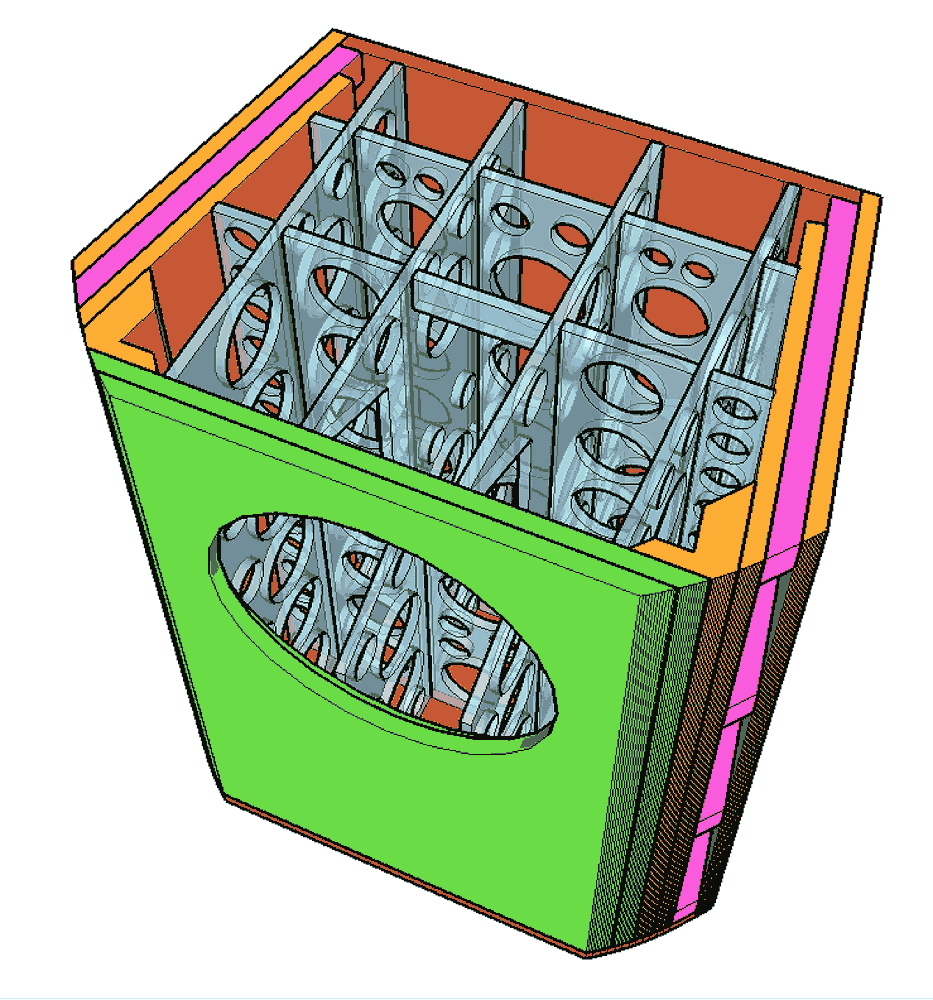
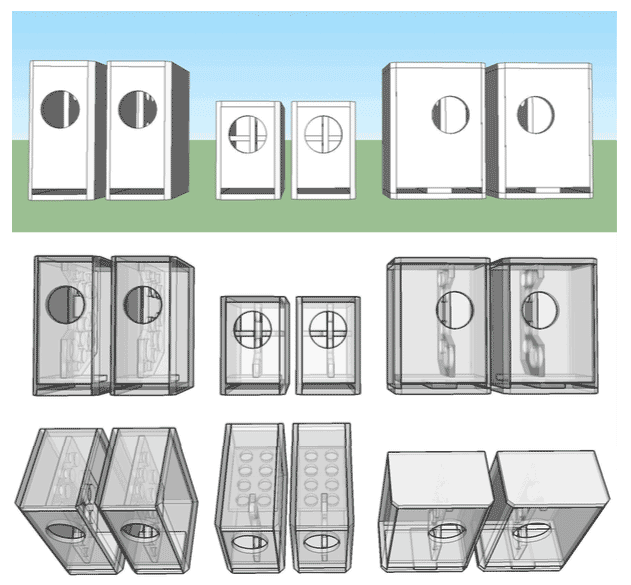
Note that the tall-slim orientation is the least well braced.
Here is the “premeire” version of the above, they have “triple” sides, and trapezoidal top & bottom.

And while i was looking this is a subwoofer:
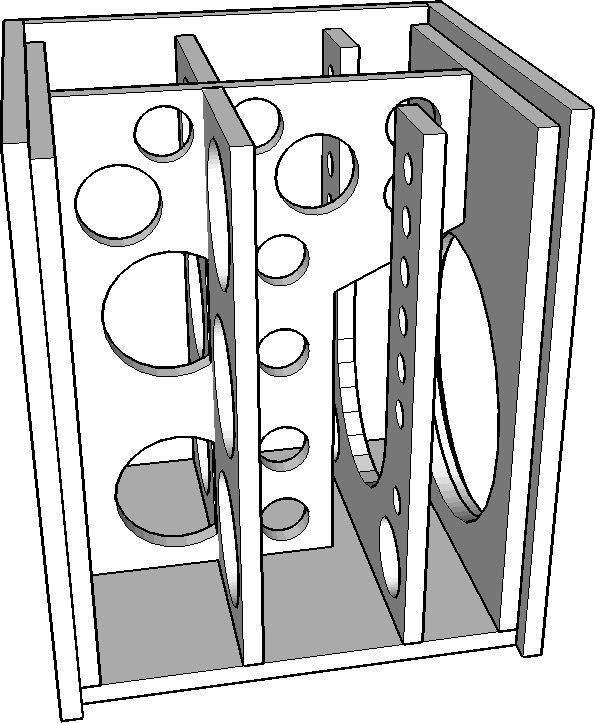
dave
The prime rule that comes out of the Tappan experiments is:
0/ the aspect ratio of the subpanels created by the brace should have higher aspect ratios than the panel being braced.
I add this corallary:
1/ the aspect ratios of the subpanels should not be equal
The above mostly means don’t put the brace in the middle.
Note that the diagonal is not as effective as the parallal brace across the longest dimension. Not sown or verified is that trapezoidal/non-rectangular subpanels would be even better, but, from experience they are a PITA.
Here is an over the top example for a large box (135 litres) and a minimally braced 9 litre. The brace directly contacts/supports the driver bracing it against the back (& top-bottom) dramatically lowering chances of the baffle — the waekest panel — starting to resonate.


Note that the tall-slim orientation is the least well braced.
Here is the “premeire” version of the above, they have “triple” sides, and trapezoidal top & bottom.

And while i was looking this is a subwoofer:

dave
Ah ok thanks for explaining. I should have done all that, it would have been easy enough to incorporate if I had planned it before buying all my wood.
Oh well, hopefully this works well enough until I get around to building something like the Pensils which I will build properly. I suspect some stuffing will be required which I know isn't ideal in a ported box....
Oh well, hopefully this works well enough until I get around to building something like the Pensils which I will build properly. I suspect some stuffing will be required which I know isn't ideal in a ported box....
Thanks all for the advice, just an update to show it was not wasted. These things are built and I am so happy with the sound. Such a wonderful effortless presentation. The bass isn't crazy, but it's well integrated and I can definitely live with this for a while with no pressing need to get a sub. I was skeptical about the run in period but patiently did the full hundred hours and there is no doubt in my mind that things improved during that period.
A friend of mine with some $10kAUD B&W's today swore he was never spending that kind of money again after hearing the total cost of these speakers.
All in all, very happy and definitely a full range convert! I can't help thinking I am keen to give a Voigt pipe a go with these drivers now…
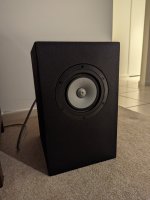
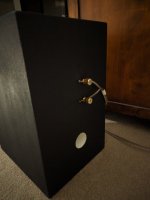
A friend of mine with some $10kAUD B&W's today swore he was never spending that kind of money again after hearing the total cost of these speakers.
All in all, very happy and definitely a full range convert! I can't help thinking I am keen to give a Voigt pipe a go with these drivers now…


Last edited by a moderator:
- Home
- Loudspeakers
- Full Range
- Seeking advice on first full range speaker build

